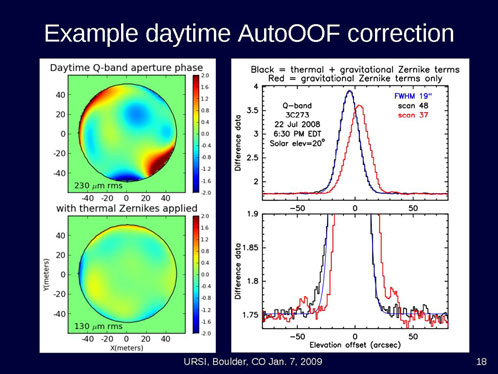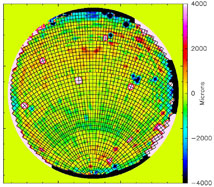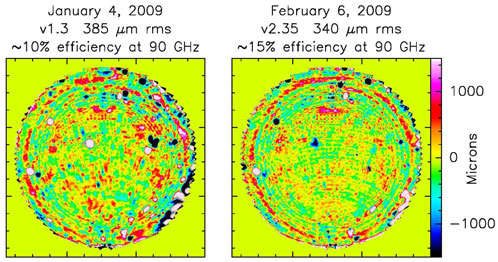Todd Hunter, Fred Schwab, and Martin Bloss
With the goal of boosting the GBT high-frequency performance, the Precision Telescope Control System (PTCS) project team has been working to improve the surface accuracy. The problem naturally divides into two parts: large-scale errors due to thermal and gravitational distortion; and small-scale errors due to actuator and panel setting errors. These disparate regimes require the use of complementary techniques: out-of-focus (OOF) holography and traditional holography. Excellent progress has been made with both techniques. In December, we released an observing tool to measure and correct large-scale errors during daytime observing. In January, we acquired high-resolution traditional holography maps that have resulted in the first significant reduction in the small-scale surface error since the initial photogrammetry corrections were applied in 2001.
Out-of-Focus (OOF) Holography
The GBT uses OOF holography to measure the large-scale errors on the primary reflector. Maps of a quasar are acquired at three focus settings. By modeling the aberrations in the resulting three images, the mirror deformation is determined and expressed as a sum of Zernike polynomials. On the GBT, the deformation varies with elevation, indicating a residual error in the finite element model. Since late 2006, the active surface of 2209 actuators has been automatically removing this error by applying elevation-dependent Zernike terms, leading to a stable nighttime aperture efficiency (44% at Q-band).
To extend this performance into daytime, a new “AutoOOF” tool was released in December for use by high-frequency (Ka & Q-band) observers. As described in the Oct 08 eNews, AutoOOF allows the observer to measure the shape of the surface and apply the necessary corrections at the push of a button. A full AutoOOF cycle takes ~ 20 minutes and should be factored into the overhead time for observations.
An example of the improvement delivered by AutoOOF at Q-band is shown in Figure 1. With AutoOOF, the large-scale error can now be held to less than 1/50 wavelength rms. The next phase in AutoOOF development is integration with the 64 pixel MUSTANG bolometer camera, built in conjunction with the University of Pennsylvania, NASA, and NIST. Using the experimental OOF holography results from the 2007-2008 season of MUSTANG, we found that data from all of the working pixels can be safely included in the fit, providing a robust measurement of the surface with only a few minutes of observing time. Data from the current commissioning season indicate significant improvements to the nighttime efficiency at 90 GHz using the AutoOOF technique. Daytime tests of AutoOOF with MUSTANG will be attempted soon.

Figure 1: (Left panels) surface maps obtained before (top) and after (bottom) the application of AutoOOF corrections. The rms values represent the large-scale component of the surface error. (Right panels) The 43 GHz beam profiles before and after application of the AutoOOF corrections. Note the reduction in beam width and the increase in intensity.
 Zoom
Zoom
Traditional Holography
The GBT’s 12 GHz phase-coherent (traditional) holography system was upgraded over the past year and commissioned in December. The system is composed of two room temperature, high dynamic range receivers and a narrowband correlator. Designed to observe strong beacon signals from geostationary satellites, one receiver looks directly at the target through a 30cm feed horn, while an identical receiver looks at the same signal reflected from the dish and subreflector. The telescope is slewed in a raster pattern to obtain a large (2 degree) map centered on the satellite. The information in the resulting map is readily transformed into an image showing the deviations of the surface from a perfect paraboloid (Figure 2). This image allows us to extract a table of corrections which can be applied to refine the home positions of the individual actuators.
The first set of such corrections was tested in late January with MUSTANG and yielded a 50% increase in the 90 GHz sensitivity, indicating that the aperture efficiency is now 15%. Follow-up holography maps of the surface taken in early February confirm that the total surface error in the dish has been improved from 385 to 340 microns rms (Figure 3). The holography images are complicated by the effect of diffraction at the subreflector that produces ring-like modulations toward the outer portion of the dish which must be removed before deriving actuator corrections. In areas free of these rings and not affected by bad actuators, the repeatability between two maps is ~ 145 microns rms, suggesting that further improvement of the surface via holography is possible.

Figure 2: GBT surface image showing deviations over the range of -4 to +4 mm.The black lines indicate the borders of the 2,004 surface panels. An actuator resides at each intersection. The white and black spots reveal about a dozen individual actuators with highly discrepant positions. These units were subsequently inspected and are undergoing repair.
 Zoom
Zoom
Because GBT engineers were able to fit the receiver into the normally unused Gregorian turret slot above Zpectrometer, we have the opportunity to iterate the holography measurements and corrections this season. For example, if we can reduce the total surface error from 340 to 240 micron rms, then we would reach 35% aperture efficiency for MUSTANG at 90 GHz and 20% for a (future) W-band receiver operating at 115.27 GHz (CO 1-0).
Additional information about the PTCS projects. For more information on GBT’s holography capabilities contact Todd Hunter at thunter@nrao.edu.

Figure 3: (Left panel) Holography map of surface version 1.3 obtained January 4, 2009. (Right panel) Holography map of surface version 2.35, which has the corrections from the January map applied. The surface error is reduced and the measured aperture efficiency at 90 GHz is increased.
 Zoom
Zoom

 Zoom
Zoom
